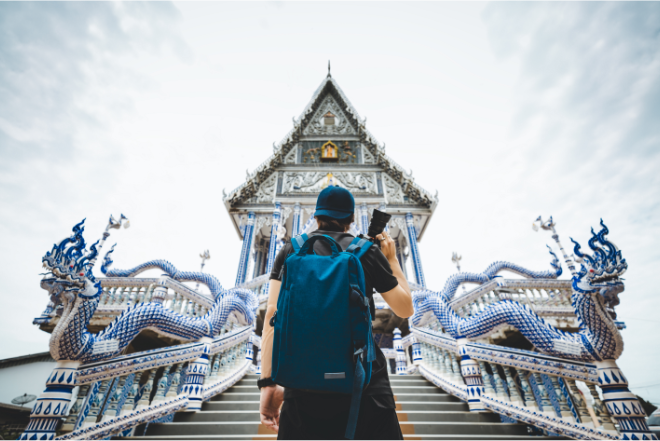
As countries in the Greater Mekong Subregion slowly move toward the "new normal,” they are also enacting phased approaches to implement tourism recovery. The challenge for the subregion’s travel and tourism sector is to manage and mitigate the impact of the coronavirus disease (COVID-19), and build back a more sustainable, inclusive, and resilient tourism sector.
During the third Policy Actions for COVID-19 Economic Recovery (PACER) Dialogue held on 26 June via video conference, Tiffany Misrahi, vice-president of policy, World Travel and Tourism Council (WTTC), emphasized the importance of strategic coordination, implementation of relief measures, removal of restrictions, and the definition of new protocols and metrics in restarting operations in the travel and tourism sector.
She also pushed for the following:
- Ensure strategic coordination between the public and private sector, as well as between and among governments to minimize confusion.
- Establish new global protocols to help rebuild confidence among travelers and assure them of safety. “Consistency is needed among destinations and countries, as well as guidance to travel providers, operators, and travelers, about the new approach to health and hygiene in a post COVID-19 world. Ideally, protocols should be industry-led, following internationally accepted guidelines, and backed by governments regulations,” said Misrahi.
- Provide regulatory relief to help the sector deal with the drop in tourism. WTTC proposed providing tax relief and reducing charges for aircraft slot allocations, and reinvestment of tourism-specific taxes.
- Establish metrics to measure and manage the rate/extent/time of recovery. Crises are best managed when properly monitored and evaluated, noted WTTC. Metrics will allow for evidence-based decision-making across industry and government, and provide data that can help deliver evidence-based communication to travelers and inspire confidence.
- Address private sector liquidity through explicit political and financial commitment from governments, such as the implementation of tourism stimulus packages, with support to both large businesses and SMEs.
- Ensure travel restrictions remain proportionate to the public health threat and must be managed accordingly. WTTC emphasized sharing of information on the lifting of travel restrictions and addressing the need for expatriate and migrant workers by relaxing or removing visa requirements and other restrictions to labor mobility. WTTC also underscored that governments should collaborate to ensure access to “safe” areas, as well as make effective use of global gateways.
- Build sustainability in building back better through strengthened destination stewardship. COVID-19-induced closures offer destinations an opportunity to reimagine tourism, noted WTTC. It pushed for a discussion among public and private sectors and the communities on how to better deliver on shared objectives of developing, promoting, and managing sustainable tourism experiences that simultaneously deliver on market expectations and support the needs of host communities. As an example, Maya Bay in Thailand closed due to overcrowding. As it reopened, the focus is now on sustainability rather than arrival numbers.
Rebuilding traveller confidence
Reinspire wanderlust among travelers who may be more cautious after COVID-19 is another key challenge. “Expectations of travelers will be different,” noted Mario Hardy, chief executive officer, Pacific Asia Travel Association (PATA), one of the panelists in the PACER dialogue. Survey results conducted by Trip Advisor, a PATA partner, revealed cleanliness, sanitation certificates, and public display of compliance with government safety standards to be among the expectations of travelers moving forward.
Misrahi outlined policy actions to support rebuilding of traveler confidence and facilitate the sector’s further recovery:
- Lead with domestic travel.
- Encourage wanderlust while providing reassurance to rebuild travelers’ confidence. The sector must highlight that travel and tourism is “fully and safely open for business,” noted Misrahi. The travel and tourism industry is encouraged to consider appropriate pricing, packaging, and reservation/cancellation policies, and provide travelers reassurance through better visibility of health and safety protocols and offering simple, reliable, and guaranteed travel insurance to ensure travelers feel safe.
- Facilitate recovery through supportive regulation and incentives. The sector is encouraged to implement positive incentive measures to boost travel and tourism, like promotions and reduced prices. WTTC also underscored increasing direct investment in travel and tourism.
Hardy also underscored the importance of standardizing protocols, and its key role in recovery. “The challenge we all face moving forward is that each destination, each business is putting their own protocols in place. We are all keen to get people to travel again, but as time progresses, it’s important that we collaborate and standardize these protocols so that travel becomes more seamless.”
Keeping people dreaming about the Mekong Region
Jens Thraenhart, executive director, Mekong Tourism Coordinating Office (MTCO), another panelist, shared initiatives the MTCO is implementing to help industry players and keep the Mekong region on tourists’ minds:
- Experience Mekong Collection virtually curates social enterprises that make traveling to the Mekong region a unique experience.
- Mekong Moments and Mekong Deals urge people to share their experience of traveling to the Mekong region. By crowdsourcing content and hyperlinking these to relevant businesses, MTCO hopes to keep wanderlust for the Mekong going, and providing more avenues for the region’s SMEs to promote their businesses.
Crisis Planning for the Industry
As the industry discusses restart and recovery, Hardy emphasized the necessity of crisis planning for travel and tourism SMEs across Asia and the Pacific moving forward. He explained, “65% of businesses were not prepared for any type of crisis at all. No plans, no crisis communication management, not enough runways in terms of financials to sustain their business for an extended period of time in any kind of crisis. This shows the importance of helping the industry to prepare itself for future crises after we get out of this. Crisis will continue to happen moving forward.”
This article was first published by the Greater Mekong Subregion on 3 July 2020.

